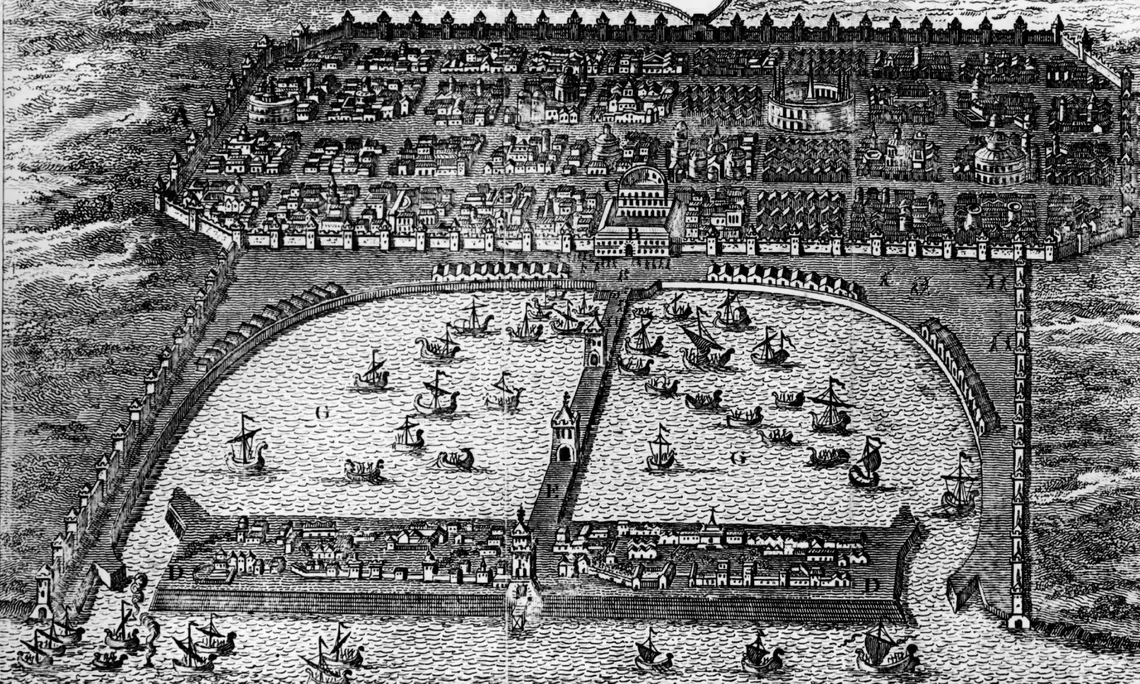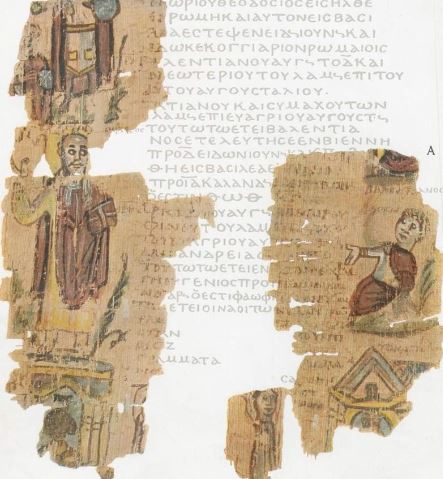
ALEXANDRIA (Gk. Alexandria)
A seaport on the Mediterranean Sea, in the Western Delta at the mouth of a branch of the Nile River. The site is ca. 210 km. (130 mi.) N of Cairo, set on a slight elevation between Lake Mareotis on the south and the Sea on the north and west. This location was selected by Alexander the Great himself, who gave instructions to Cleomenes of Naukratis to arrange the finances and construction, while Deinocrates of Rhodes was commissioned to create a city plan. On 7 April 311 b.c.e. Alexandria was founded and Ceomenes became its first governor. Of all the cities and monuments built by Alexander or in his name, this proved to be the most durable and productive.
Alexandria has always been particularly well situated for sea-going commerce, featuring a peninsula known since Greco-Roman times as Cape Lochias which with the mainland shoreline forms a large bay and harbor protected by the island of Pharos. Here stood the Pharos lighthouse, one of the seven wonders of the ancient world (cf. Strabo Geog. 17). Since Greco-Roman times the site has sunk 4 m. (13 ft.) in elevation, modifying the shoreline and submerging many features of the ancient city, including the harbor itself, and parts of the Jewish quarter and the palaces of the nobility.
When Alexander died in 323, Ptolemy I Soter, one of his three senior military commanders, took over the southeastern part of the empire, establishing a family dynasty which ruled Egypt from Alexandria until 80 b.c.e. Under the Ptolemies Alexandria flourished as the capital of Egypt and as an intellectual, political, and economic center. As such it became the cultural and educational heart of the Hellenistic world.
In 306 b.c.e. Ptolemy established the library of Alexandria in honor of Alexander, whose body he had brought from Babylon and buried in his capital. The library achieved great fame under such librarians, research scholars, and scientists as Demetrios of Phaleron (235-283), Zenodotus of Ephesus (325-260), Apollonius of Rhodes (305- 240), Callimachus of Cyrene (305-ca. 235), and Eratosthenes of Cyrene (275-195). It was actually a university center for research, teaching, and writing in science, the arts, literature, history, linguistics, and the humanities in general. The scholars and the acquisition of every possible book in the world were supported by generous stipends or allocations from the royal treasury. Demetrios collected 250 thousand books, and by the time of Julius Caesar’s visit the library could boast more than 1 million volumes, in addition to a large collection of archaeological and historical artifacts and scientific instruments.
The philosophy and science for which the library has been famous since its founding was Aristotelian rational empiricism. Ca. 100-150 c.e. the stability of the Mediterranean world was greatly disturbed by the expansion of the Roman Empire, and the speculative idealism of Platonism gained influence. Religious and transcendental philosophy was in the ascendancy, mystery religions flourished, and the great research center of Alexandria shifted from the natural and social sciences toward religious speculation. Middle Platonism came to dominate Hellenistic culture. Philo Judaeus (30 b.c.e.-50 c.e.) became the most remembered scholar in Alexandria at the time of Christ. Two centuries later Neo-Platonism competed with Christian speculative theology for dominance. Plotinus (203-ca. 270), Porphyry (ca. 234-305), Olympius (350-391), and Hypatia (350-415) are prominent Neo-Platonists. The Christian perspective was represented by the Catechetical School of Clement (150-215) and Origen (185-253) and by such prelates as Theophilus (ca. 350-435) and Cyril (ca. 375-444).
Alexandria is thought to have played an important role in the rise of Christianity, influenced by the Apostle Mark, for whom the central cathedral is named. The speculative allegorical theology of the Alexandrian theologians proved to be the definitive influence that shaped orthodox Christian doctrine in the Ecumenical Councils from Nicea (325) to Chalcedon (451 >. After Chalcedon secular or pagan Neo-Platonism declined, and Alexandrian Christianity absorbed its essential tenets to create the Alexandrian school of Christian Neo-Platonism, an important influence on Western civilization.
In 47 b.c.e. Julius Caesar fought a naval battle in the bay at Alexandria, during which some 50 thousand volumes from the library were destroyed in a warehouse fire. In 391 c.e. Theophilus destroyed the pagan cohorts of Olympius and another who were barricaded in the public extension library in the Serapeum, destroying the pagans and another 50 thousand volumes. During the Arab conquest the city and the library were sacked in 641-642.
Philo’s prominence in Alexandria at the time of Christ symbolizes the significance of the Jewish community in the life of the city. Alexander is reported to have settled a large number of Jews there at the outset. The translation of the Hebrew Bible into Greek, the LXX, was completed there sometime between 150 and 50 b.c.e. Philo says the community had grown to one million by his time. A number of repressions by Imperial Rome and subsequently by the Christian archbishops reduced the community to virtual extinction by 150 b.c.e. It resurged by the 4th century but was eliminated by Cyril of Alexandria in 415, the same year in which he had the pagan philosopher Hypatia murdered.
Bibliography.
J. H. Ellens, The Ancient Library of Alexandria and Early Christian Theological Development. Occasional Paper 27 (Claremont, 1993-95);
B. A. Pearson, “Earliest Christianity in Egypt,” in The Roots of Egyptian Christianity, ed. Pearson and J. E. Goehring. Studies in Antiquity and Christianity 1 (Philadelphia, 1986), 132-59.
Harold Ellens
Despite all this, the library is most famous (or rather infamous) for its burning. Throughout its near 1,000-year history, the library was burned multiple times.
According to Plutarch, the first person to blame is Julius Caesar. On his pursuit of Pompey into Egypt in 48 BCE, Caesar was cut off by a large fleet of Egyptian boats in the harbor of Alexandria. He ordered the boats to be burned. The fleet was destroyed, but the flames spread to the city and the library. It’s not known how much of the library was destroyed.
When Caesar documented this attack in his account of the civil war, he left out the destruction of the library; however, this is not uncommon of Caesar, who often left out damaging facts about himself in his writing. However, despite this loss, the library lived on. According to reports, Mark Antony gave Cleopatra 200,000 scrolls for the library well after Caesar’s attack.
The second, more famous, burning of the library came at the hands of Theophilus who was Patriarch of Alexandria from 385 to 412 CE. He turned the Temple of Serapis into a Christian church. It is likely that the collection was destroyed by the Christians who moved in. Some sources say nearly 10 percent of the library’s collection was housed in the Temple of Serapis. In the following years, the Christian attack against the library escalated, and the last great pagan philosopher and librarian, Hypatia, was tortured and killed.
According to church historian Socrates Scholasticus or Socrates of Constantinople, the emperor granted permission to destroy the temple in response to heavy solicitation by Theophilus.

Seizing this opportunity, Theophilus exerted himself to the utmost … he caused the Mithraeum to be cleaned out… Then he destroyed the Serapeum… and he had the phalli of Priapus carried through the midst of the forum. … the heathen temples… were therefore razed to the ground, and the images of their gods molten into pots and other convenient utensils for the use of the Alexandrian church’ —Socrates Scholasticus, The Ecclesiastical History” (Wikipedia article on Theophilus of Alexandria, accessed 11-28-2010).
A papyrus fragment from an illustrated Greek chronicle written in Alexandria circa 450 CE has survived, depicting Theophilus standing triumphantly on top of the Serapeum, providing a near contemporary portrait of Theophilus in the context of these events. _________________________________________________________
The final blow came in 640 CE when Alexandria came under Muslim rule. The Muslim ruler, Caliph Omar, asserted that the library’s contents would “either contradict the Koran, in which case they are heresy, or they will agree with it, so they are superfluous.” The contents of the library were then supposedly used as tinder for the city’s bathhouses. Even then, it is said that it took six months for all the materials to burn.
The ancient library of Alexandria and early Christian theological development
The Destruction of the Great Library at Alexandria